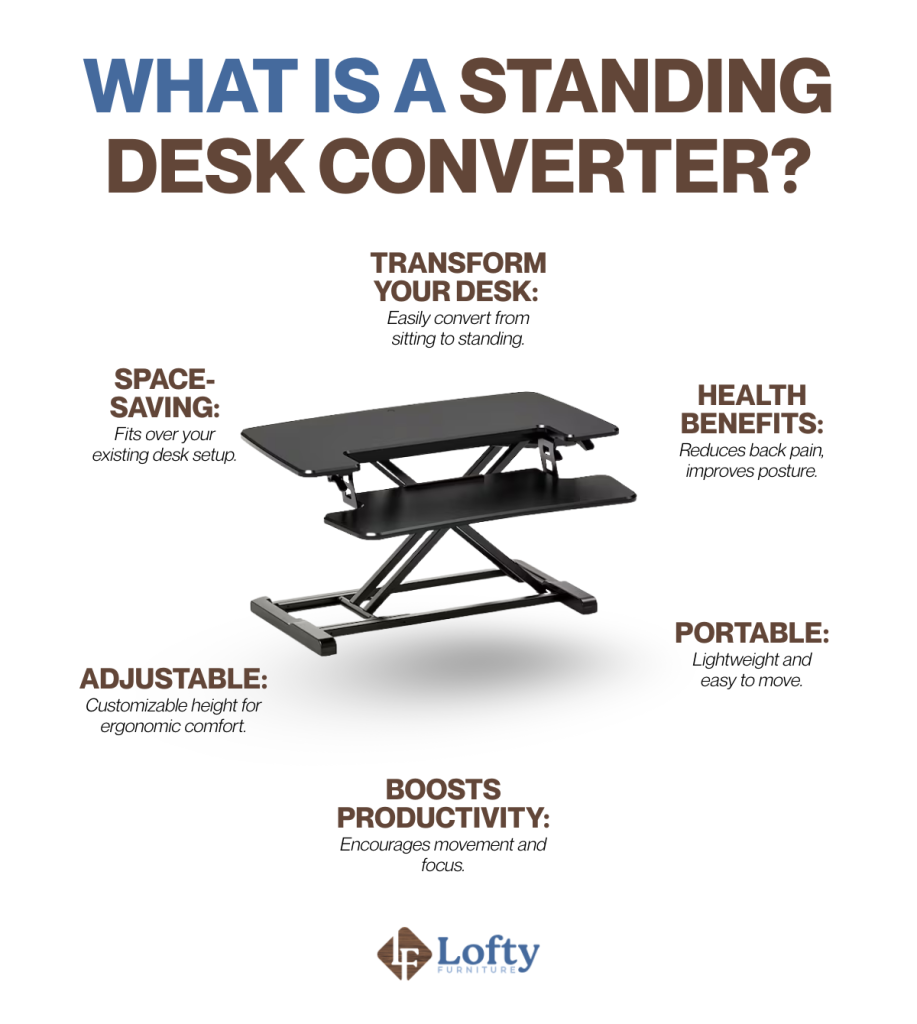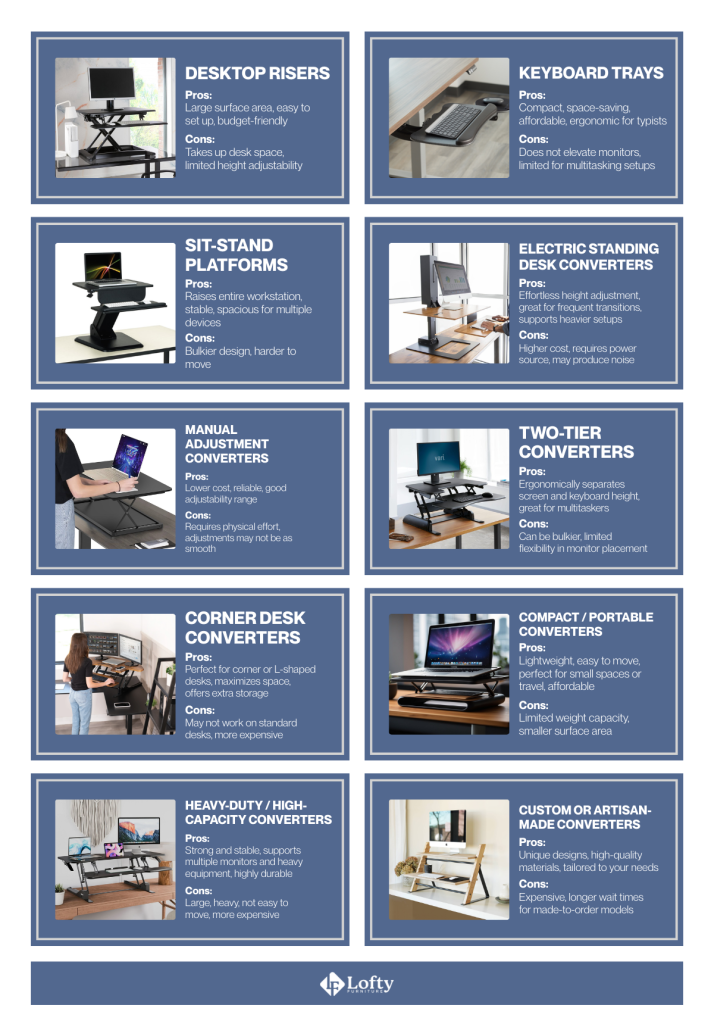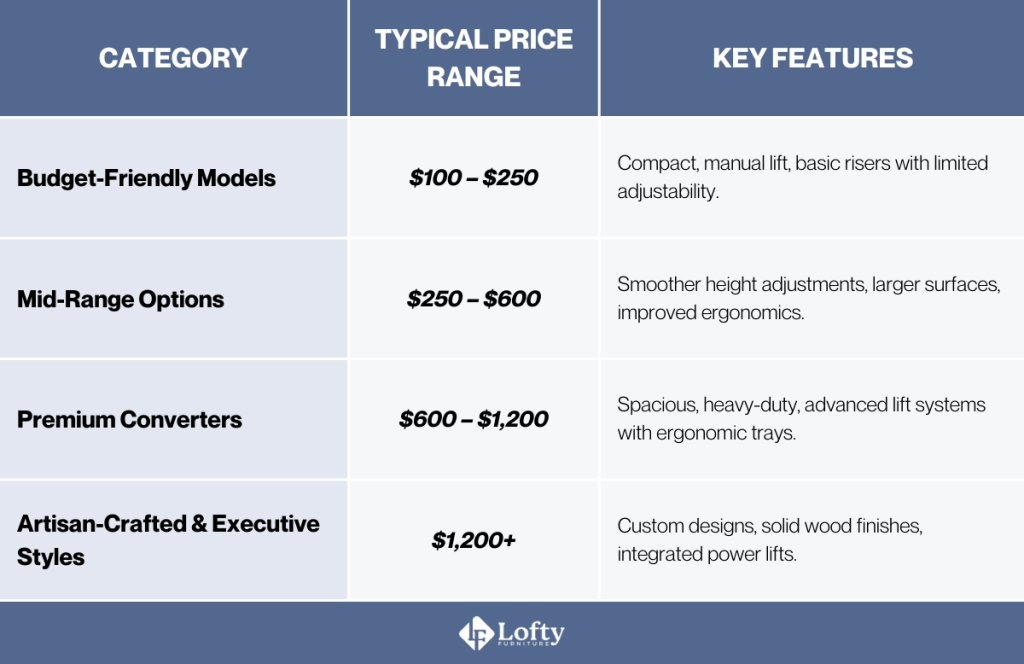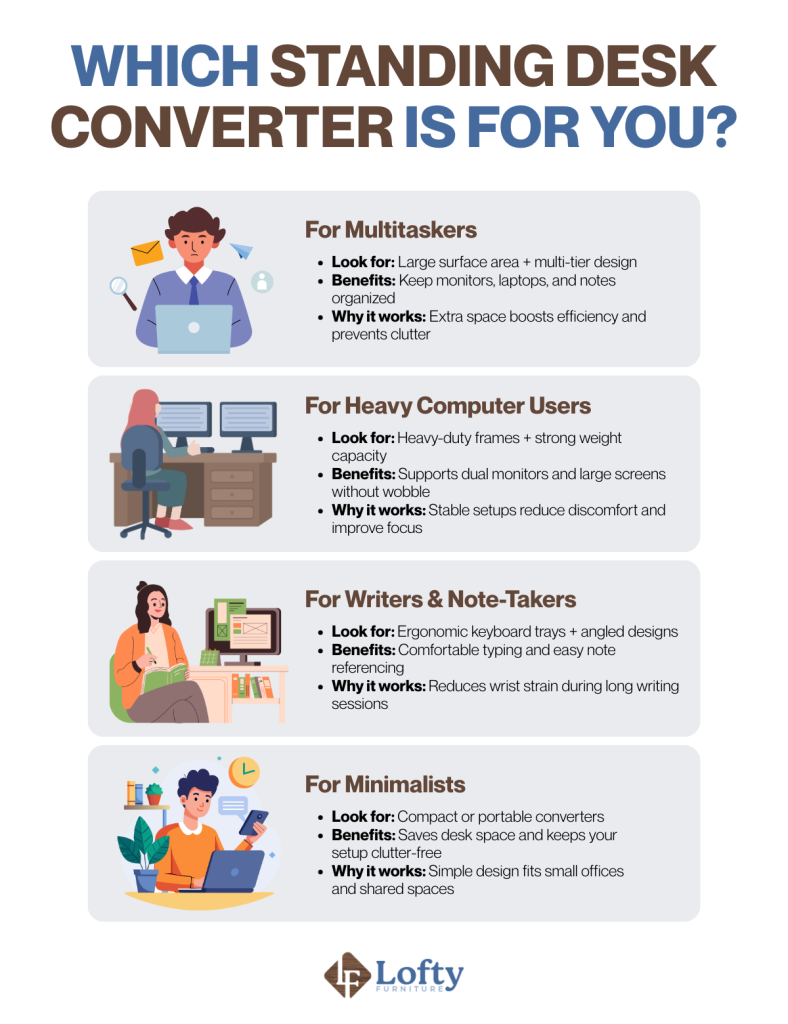The way we work has evolved, and long hours at a desk can take a serious toll on posture, energy, and overall health, making standing desk converters an increasingly popular, flexible, and affordable alternative to full standing desks. They integrate easily into your existing setup and help cut down sedentary time, with sit-stand desks shown to reduce daily sitting by over an hour while supporting better posture and energy levels.
Key Takeaways:
- To choose the right standing desk converter, consider your ideal standing height and whether you need adjustable features to match your posture and workspace needs.
- Different types suit different needs, like typing, multitasking, or small setups.
- A sturdy, adjustable converter will last longer and feel better to use.
This guide will help you choose one that fits your workflow, whether you’re a multitasker managing multiple screens, a writer seeking ergonomic comfort, or a minimalist who values clean design.
What Is a Standing Desk Converter?
A standing desk converter is a portable unit that sits on your existing desk, letting you switch easily between sitting and standing without replacing your whole setup. With adjustable height settings and customizable surfaces, a standing desk converter offers flexibility at a lower cost than a full standing desk.

Learn more about why standing can be better than sitting, check out our guide on is standing better than sitting.
Types of Standing Desk Converters
Standing desk converters come in several styles, each designed to meet different work preferences and office setups. Understanding these options will help you choose a converter that enhances, rather than interrupts, your workflow.
Basic/Entry-Level Converters
These converters are ideal for users seeking a simple, affordable way to elevate their workstation without extra features.
Desktop Risers – Fixed-height platforms that sit on top of your existing desk. Great for immediate setup and simple screen elevation.
Keyboard Trays – Compact units that raise only your keyboard and mouse for ergonomic typing. Perfect for minimalist setups or those with an elevated monitor.
Compact/Portable Converters – Lightweight, minimal units that fold for storage or transport. Ideal for small desks or hybrid workers.
2. Adjustable Converters
Converters in this category allow height adjustments, enabling smooth transitions between sitting and standing for improved ergonomics.
Sit-Stand Platforms – Lift the entire workstation in one motion, often spring-assisted or pneumatic. Suitable for dual monitors and larger setups.
Electric Standing Desk Converters – Motorized units with push-button controls and programmable heights. Excellent for frequent sit-stand transitions.
Manual Adjustment Converters – Height-adjustable via levers or knobs. Durable, dependable, and budget-friendly.
3. Ergonomic/Task-Specific Converters
These are designed to optimize posture and workflow for specific tasks or setups.
Two-Tier Converters – Separate platforms for monitor(s) and keyboard/mouse for better posture and workspace organization.
Corner Desk Converters – Fit L-shaped or angled desks, maximizing unconventional spaces while supporting multiple screens.
4. Specialty/High-Capacity Converters
Built for durability, performance, and unique design needs.
Heavy-Duty/High-Capacity Converters – Reinforced units for multiple monitors, desktop towers, and heavy equipment. Ideal for designers, gamers, and tech-heavy workstations.
Custom or Artisan-Made Converters – Handcrafted to fit specific ergonomic, aesthetic, or dimensional preferences. Combine functionality with a high-end look.

Key Features to Look for in a Standing Desk Converter
When choosing a standing desk converter, it’s important to focus on features that go beyond basic functionality. The right design not only supports your health but also enhances your overall work environment. A well-crafted converter should feel like an integral part of your workspace, offering durability, style, and long-term comfort.
Design That Enhances Your Workspace
Your desk converter should feel like part of your workspace, not just an add-on. Whether you prefer a modern, minimalist look or the warmth of handcrafted wood, the right design enhances both aesthetics and motivation.
Effortless Height Adjustability
A quality converter makes sit-stand transitions smooth and simple. Quiet lift mechanisms and multiple height settings allow you to switch positions easily, keeping you comfortable without disrupting focus.
Ergonomics and Comfort
Converters designed with ergonomics in mind support healthy posture and reduce strain. Spacious trays and proper typing angles help protect your wrists, shoulders, and back—an important factor since ergonomic technology can ease musculoskeletal pain and improve comfort at work, making long hours easier to manage.
Durability and Longevity
Durable materials and solid craftsmanship ensure your converter lasts. Unlike mass-produced models, artisan-made options offer strength, stability, and timeless design for years of reliable use.
Seamless Workspace Integration
A good converter should fit seamlessly into your workflow. Features like cable management, monitor compatibility, and stable platforms keep your setup organized, efficient, and clutter-free, especially since ergonomic interventions have been shown to reduce low back pain and improve comfort.
Cost
When considering a standing desk converter, price is an important factor to keep in mind, as it often reflects the features you get. Higher-priced models usually offer smoother height adjustments, larger surfaces, and better durability, while budget-friendly options may be more compact and basic but still functional for occasional use. Balancing cost with the features you need can help you find the right fit for your workspace.

Explore our collection of Amish adjustable desks designed with craftsmanship and care.
Measuring and Checking Standing Desk Converters Before You Buy
Before purchasing a standing desk converter, it’s important to ensure it fits your workspace and supports proper ergonomics. The right converter will help you maintain comfort and productivity whether sitting or standing. Here are the key factors to measure and consider:
Desk Dimensions
Width: Most desks range from 48–72 inches. Leave at least 6–12 inches of clearance on each side for movement and accessories.
Depth: Standard desk depths are 24–36 inches. Converters typically need 20–30 inches of usable depth to accommodate a monitor, keyboard, and mouse.
Height: Most desks are 28–30 inches tall. Make sure the converter fits under any overhead fixtures (like shelves or lights) and allows for comfortable legroom when seated.
Weight Capacity
Check your existing desk’s weight limit to ensure it can safely support the converter and any equipment (monitors, laptops, etc.) placed on it.
Check the Height Adjustment Range
Proper height adjustment is key to ergonomic comfort. Your elbows should rest at about a 90° angle, whether sitting or standing.
Sitting: Elbows should bend at 90°–100°, typically 24–30 inches from the floor.
Standing: Elbows should remain at 90°, typically 38–48 inches from the floor.
Height Guidelines:
- Under 5’5” (165 cm): 38–42 inches
- 5’5”–5’10” (165–178 cm): 42–46 inches
- Over 5’10” (178 cm+): 46–48 inches
If you’re primarily typing, focus on getting a converter that allows precise keyboard height adjustment. For multitasking (e.g., using multiple screens, writing, video conferencing), look for a larger surface area and a wider height range to accommodate various tasks comfortably.
If you still can’t decide which standing desk converter is for you, here’s another guide you can use as a reference:

Common Mistakes to Avoid When Choosing a Standing Desk Converter
When selecting a standing desk converter, it’s important to avoid common mistakes that can disrupt your workflow. First, don’t prioritize price over quality. Cheaper models often lack stability and durability. Ensure the converter has an adjustable height to maintain ergonomic posture and comfort. Always measure your desk and equipment before buying to avoid crowding or poor fit.
Be mindful of the weight capacity. Overloading can damage both the converter and your gear. Look for cable management features to keep cords organized and out of the way. Finally, check that the converter fits seamlessly into your workspace without wobbling or blocking drawers. These steps ensure your converter supports both productivity and comfort.
Conclusion: Choosing the Right Standing Desk Converter
A standing desk converter isn’t just an office accessory—it’s an investment in your health, comfort, and productivity. Research shows that sit-stand workstations can reduce back pain, making them a smart choice for long-term wellness and daily efficiency. The right option depends on your workflow, whether you’re a multitasker with multiple screens, a writer needing ergonomic support, or a minimalist saving space. By focusing on size, weight capacity, adjustability, and ergonomics, you can create a workspace that feels natural and efficient.
Ultimately, the best converter is one that works with you, not against you. Measuring your space, checking the adjustment range, and prioritizing quality over quick savings ensure you’ll enjoy long-term benefits instead of daily frustrations. When chosen wisely, a standing desk converter helps reduce sedentary time, supports better posture, and makes your workspace more adaptable to the demands of modern work.
Frequently Asked Questions
Can I turn a regular desk into a standing desk?
Yes. A standing desk converter is specifically designed to sit on top of your existing desk, instantly transforming it into a sit-stand workstation. This allows you to enjoy the health and productivity benefits of a standing desk without replacing your current setup.
How do you lower a standing desk converter?
Most converters use a lift-and-release or lever-based mechanism. To lower it, you simply hold the adjustment handle, gently guide the platform down, and release it when it reaches your desired height. Always check the manufacturer’s instructions to ensure smooth and safe operation.
How much does a standing desk converter weigh?
The weight of a converter varies depending on the type and size. Compact models may weigh around 15–20 pounds, while heavy-duty, multi-tiered platforms can weigh 30–50 pounds or more. Consider both the portability and stability needs when choosing the right one for your workspace.
